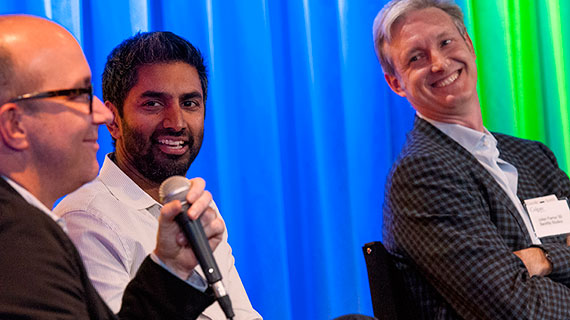
Michael Sippey ’90, vice president of product and design at Twitter; Bharat Mediratta ’92, distinguished software engineer at Google; and Julian Farrior ’93, founder and chief executive officer of Backflip Studios (left to right) speak at the launch of the Digital Media and Technology Professional Network.
With public stock offerings by and , a smartphone launch in play by Google — and ĎăĂŰÓ°ĘÓ making major strides in its own mobile platforms — it was an exciting week for ĎăĂŰÓ°ĘÓ to be in Silicon Valley to launch its new .
The reception and panel discussion drew 150 alumni and parents who work in all facets of the business, from venture capitalists and entrepreneurs, to marketing executives and product developers, all fiercely loyal to ĎăĂŰÓ°ĘÓ and grateful for the liberal arts education they received.
And as one might expect from any ĎăĂŰÓ°ĘÓ conversation, there was depth and breadth, as well as humor and drama.
, distinguished software engineer at Google, ribbed , vice president of product and design at Twitter, about the length of his commentary on the massive transformation to mobile in developing markets (“That was more than 140 characters!”). Later, in response to a question about what technology areas might be unimportant a decade from now, Sippey retaliated with “The whole search thing!”
, founder and chief executive officer of , which he recently sold to Hasbro, offered to “take the conversation up a level” — to gaming — which, he said, today is “rewarded and a great way to teach young people.”
And ’81, P’17, principal, partner and co-founder of and the consummate weaver and bobber, barely missed a beat when threatened by a nut allergy. After rustling up an EpiPen from a Google security guard, he returned to the stage and later said, “Success in the tech economy requires creative thinking and the ability to overcome obstacles.”
President Jeffrey Herbst led the wide-ranging conversation with aplomb, covering the ubiquity of mobile, threats and opportunities for higher education, the socioeconomic implications of global technology, and the need for ĎăĂŰÓ°ĘÓ, and other , to expose its students to the West Coast culture of “try and fail.”
Mediratta described his career path, working for five failed companies before joining Google. “On the East Coast,” he said, “you wouldn’t get the fifth job. On the West Coast, people are perfectly happy to hire you.”
Farrior, who is based in Colorado, agreed: “Great ideas happen every day. People repeatedly try interesting and outrageous ideas, many of which will fail.”
Last year, California became the third most popular state for applications from prospective ĎăĂŰÓ°ĘÓ students, and the California contingent of alumni and parents is growing. Today, approximately 2,500 alumni live in the state, with more than 1,200 in the San Francisco club.
’80, vice president of institutional advancement, has witnessed the growth.
“Over the past 15 years I have watched our alumni move into real leadership positions at some of the more significant software, hardware and Internet companies,” Decock said. “Of course, many have undertaken some real risks in their careers and suffered some distinct failures, but the persistence and drive that was clearly honed on our little campus has served them well as the digital media and tech industry has evolved to the mature state we see today.”
“We want to from ĎăĂŰÓ°ĘÓ to here,” Herbst said. The day after the launch, Herbst convened a new West Coast Advisory Council of alumni, parents, and friends to exchange ideas and provide feedback on issues of technology, entrepreneurship, recruitment, and marketing.
